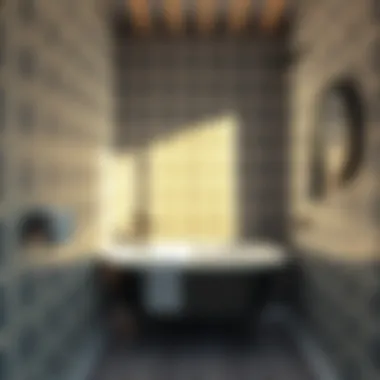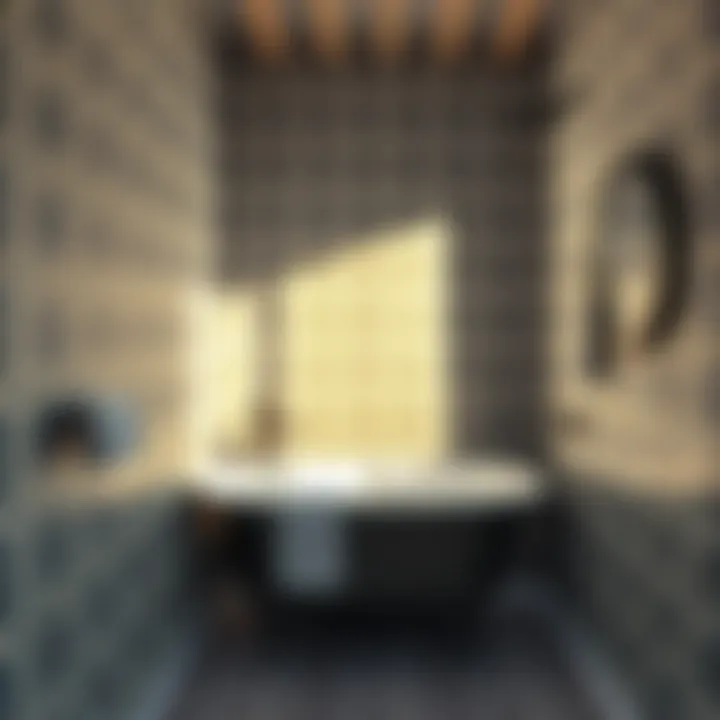Best Tile Choices for Small Bathroom Spaces


Intro
Selecting the right tile for a small bathroom is more than just a cosmetic choice; it sets the tone for the entire space, intertwining aesthetics with functionality. In a compact setting, every inch counts, and the right tile can make the difference between a cramped look and a stylish sanctuary. This guide is designed to take you through the process of making informed decisions about tiles, ensuring that both homeowners and renters can achieve a bathroom that feels spacious and inviting.
When thinking design in a smaller bathroom, choices abound. From ceramic to porcelain, the options are as varied as they are exciting. But it's not just about picking a pretty pattern; clever choices can brilliantly reflect light, enhance visual depth, and even heighten the sense of cleanliness.
The beauty of tile lies not only in its versatility but also in its ability to offer practicality. Easy to clean and exceptionally durable, tiles can withstand the daily wear-and-tear of a bathroom environment. Therefore, understanding the material properties and styles becomes essential, particularly for those hoping to maximize their compact spaces.
Design Inspirations
Trending Styles
As we look into the current trends in tile design, we see a shift towards minimalist aesthetics that prioritize function without sacrificing style. Subway tiles, for instance, have made a remarkable comeback, often seen laid in a herringbone pattern, adding a subtle dynamism to the walls. Alternatively, large-format tiles can diminish grout lines, creating the illusion of a larger area. Whatever your taste, there's no shortage of options to consider. Just remember that less sometimes truly is more, particularly when working within spatial constraints.
Consider, too, the allure of tactile surfaces. Textured tiles can add depth and interest without overwhelming the senses. These subtle details can transform a simple shower area into a cozy nook, perfect for unwinding after a long day.
Color Palettes
When it comes to color, the right choices can open up a world of possibilities in a small bathroom. Lighter hues, such as soft creams and gentle pastels, can brighten up the space, creating an airy feel. Using a monochromatic scheme can also streamline the look and make it visually appealing.
However, this doesn't mean you have to shy away from bolder colors altogether. A single wall adorned in deep navy or emerald green can serve as an exquisite focal point. Mixing textures can enhance this effect even further. Try incorporating dark tiles with gloss finishes and contrasting them against matte light-colored ones for a sophisticated look that still feels curated.
"It's not just the tiles; it’s how they interact with the elements around them that matters most in compact spaces."
Incorporating your personal flair can significantly elevate the design, allowing homeowners to express themselves while adhering to practical considerations. Caution is advisable; choose your colors and styles thoughtfully to forge a cohesive look.
Culmination
As we embark on the journey of selecting tiles for a compact bathroom, keep in mind the essential interplay of design and utility. The forthcoming sections will delve deeper into specific materials and practical tips, equipping you with the knowledge required to transform your bathroom. In the realm of small spaces, each choice matters—let's ensure you make the right ones.
Understanding the Unique Challenges of Small Bathrooms
When it comes to tweaking or transforming a small bathroom, there's much more than meets the eye. The tight space poses unique challenges that require creative solutions and thorough understanding. This section aims to shed light on why recognizing these challenges is essential for anyone looking to optimize their compact bathroom.
A small bathroom doesn't equate to less importance. It's often one of the most frequented areas in a home, yet it can feel cramped and uninviting if not properly designed. The main challenge lies in the limitations of space, which can affect both functionality and aesthetics. Knowing how to navigate these constraints is key to creating a stylish yet practical environment.
Spatial Constraints
The very nature of small bathrooms means that every inch counts. One must consider how spatial constraints can influence tile selection. For instance, larger tiles may look appealing but can sometimes make a room feel even smaller if not laid out correctly. Conversely, tiny tiles might add a bit of visual interest but can also create a cluttered effect.
Thinking about the layout is crucial. When deciding on tile size, it’s advisable to also factor in the arrangement and usability of fixtures like sinks and toilets that are often squeezed into the corners. A well-planned layout allows one to maintain flow in the bathroom, ensuring it remains functional without appearing overcrowded.
Whether pondering over a cheerful mosaic design or the classic elegance of ceramic, one must weigh options against the limitations imposed by space. Think about using large format tiles that minimize grout lines; it can trick the eye into feeling there’s more space than there actually is. The right choice can help establish a sense of proportion and harmony in a confined setting.
Design Limitations
Next up, there are inherent design limitations to consider. Designers and homeowners alike often grapple with the conundrum of how to make a small bathroom not only usable but also visually appealing.
Limited wall and floor space means that decor choices are few and far between. Simplicity becomes a guiding principle. Selecting tiles that offer vibrant colors or intricate patterns may overpower the aesthetic if not carefully chosen.
Often, there's the struggle between wanting to showcase a personal style against the reality of available space. It's about striking an equilibrium where design doesn’t compromise accessibility. For example, intricate tile designs may look beautiful but could end up being a headache to clean and maintain.
Adopting minimalistic designs or opting for neutral colors often proves beneficial in this regard. It can evoke a sense of tranquility and make the room seem larger. Patterns can still be integrated, but in a more subdued manner, ensuring that they complement rather than dominate
In summary, understanding the unique challenges of small bathrooms is paramount in making informed decisions during the tiling process. Awareness of spatial constraints and design limitations can guide one to choices that maximize both utility and style. Every tile laid should not just be a visual asset but also a contributor to the overall functionality of the limited space.
Importance of Tile Selection
Selecting the right tile for a compact bathroom is not merely a choice of aesthetics; it significantly influences the functionality and overall vibes of the space. The tiles, being more than just a surface covering, play an integral role in the visual dynamics, comfort, and usability of the bathroom. This section delves into two crucial aspects: the impact on aesthetics and the influence on perceived space.
Impact on Aesthetics
When it comes to aesthetics, tiles set the mood of your bathroom. They are like the canvas on which the whole ambiance is painted. Choosing tiles that complement the overall design can transform a cramped, uninspiring area into a stylish retreat. For example, light-colored tiles tend to reflect more light, creating an airy feel. On the other hand, darker tones can add an elegant touch, providing depth and sophistication. The graphic aspect of the tiles, such as intricate patterns or bold colors, can be used to express personal style and taste.
Another noteworthy point is how texture plays a role in aesthetics. Smooth tiles can lend a modern appearance, while textured options add warmth and character. Some homeowners opt for tiles that mimic natural stone. This adds an organic feel, evoking the tranquility of nature within four walls.
"The right tile selection can turn a muddled bathroom into a serene sanctuary."
Influence on Perceived Space
In compact bathrooms, how space is perceived is paramount. Tile selection directly impacts this perception. Smaller tiles, such as mosaics, can create visual complexity, drawing the eye in various directions, which can paradoxically make the space feel larger. Alternatively, larger tiles tend to create a streamlined look with fewer grout lines, which contributes to a smoother visual experience.
Furthermore, the layout of tile placement can have a profound effect. Installing tiles in a diagonal pattern can elongate the appearance of the room, enhancing its dimensions. Likewise, vertical patterns can make ceilings feel taller. All these strategies serve to stretch the perception of space, making the bathroom feel less cramped and more expansive.
Types of Tiles for Small Bathrooms
When it comes to maximizing every inch of a compact bathroom, the choice of tile can make or break the space. Each type of tile carries its own unique advantages and considerations, making it vital for homeowners and renters alike to do their homework. Not only do different tiles affect aesthetics, but they also influence factors such as durability, maintenance, and installation. In this section, we will explore four main types of tiles including ceramic, porcelain, natural stone, and vinyl, dissecting their characteristics and suitability for small bathrooms.
Ceramic Tiles
Durability
Ceramic tiles are often recognized for their durability, making them a popular choice for bathroom flooring and walls. Unlike some materials that might scratch or chip easily, ceramic tiles can stand up to the test of time. This makes them a reliable choice for high-traffic areas. The key characteristic here is their resilience; they don't easily succumb to wear from foot traffic or impact. That said, even the toughest ceramic can shatter if dropped. Overall, their long-lasting nature adds considerable value in the long run, which is a crucial factor in any renovation project.
Maintenance
Another factor that enhances the appeal of ceramic tiles is their low maintenance requirements. They generally require just regular cleaning with mild detergents, offering an easy solution to keep your small bathroom looking sharp. Unlike natural stone tiles, which can demand specific cleaning agents, ceramic tiles can handle a variety of cleaning tools without the risk of damage. The downside? If not properly sealed, grouts might become stained over time. However, with a little regular upkeep, ceramic tiles remain a solid choice for any bathroom environment.
Design Flexibility
When one thinks of design flexibility, ceramic tiles truly shine. Available in a myriad of colors, patterns, and sizes, they provide homeowners the freedom to create the aesthetic they desire. From bold, geometric patterns to soft, natural hues, the possibilities are endless. This variety allows for personal expression while also catering to individual spatial needs. However, choosing the wrong color or pattern can easily lead to an overwhelming effect in a compact space, so careful selection is key.
Porcelain Tiles


Water Resistance
Water resistance is a standout trait of porcelain tiles, which are crafted to absorb very little moisture. This characteristic is particularly significant for bathrooms where excess water is a regular occurrence. The minimal porosity means they are less likely to swell or become damaged over time. This makes porcelain an excellent option for both walls and floors, especially in smaller bathrooms. Yet, the trade-off can be their weight—installation might need professional assistance due to their density.
Variety in Styles
Porcelain tiles present an incredible variety in styles, offering everything from wood-look finishes to sleek, modern designs. This versatility allows homeowners to mimic different aesthetics without sacrificing moisture resistance. Whether you want the warmth of wood or the sophistication of marble, porcelain can deliver. One potential drawback is the cost; while some porcelain can be affordable, high-end styles can stretch budgets.
Cost Considerations
Considering the cost, porcelain lays somewhere in the mid to high range. While investing in a quality porcelain tile may seem hefty at first, think of it as a wise long-term investment. Their durability reduces the likelihood of needing replacements or repairs sooner than expected. Plus, many porcelain tiles replicate expensive materials at a fraction of the cost, allowing you to achieve a high-end look on a modest budget.
Natural Stone Tiles
Luxury Appeal
There's simply no denying the luxury appeal that natural stone tiles bring to a bathroom. With rich textures and colors stemming from the Earth, they can create an upscale atmosphere. This element of elegance is hard to replicate with synthetic materials, positioning natural stone as a premium choice. However, the associated costs can be significant, placing them out of reach for some homeowners. Choosing these can elevate the room's value, but careful consideration of budget is paramount.
Porosity and Maintenance
One serious consideration with natural stone is porosity and maintenance. Unlike other materials, many natural stones require regular sealing to avoid moisture absorption, staining, and damage. While the look is stunning, the ongoing maintenance factor looms large, potentially deterring those looking for a low-maintenance option. Regular upkeep is the trade-off for that luxurious finish.
Installation Challenges
The installation process for natural stone tiles can be tricky and often warrants professional help. These materials can be heavy and demanding, requiring precise cutting to fit various corners and edges in a smaller bathroom context. Improper installation not only risks damaging the tiles but can also lead to alignment issues that affect overall aesthetics. Nonetheless, those willing to undertake the challenge will find that the result often outweighs the installation complexities.
Vinyl Tiles
Cost-Effectiveness
Cost-effectiveness is perhaps the biggest draw of vinyl tiles. Often considered the budget-friendly option, they can mimic pricier materials like wood or stone without steep price tags. This makes them accessible for those concerned about spending. The downside is that, while they are great for short-term use, a vinyl floor may not offer the longevity of harder-surfaced materials like ceramic or porcelain.
Ease of Installation
The ease of installation for vinyl tiles adds to their charm. Many types come with peel-and-stick backing, allowing even novice DIYers the chance to refurbish their bathroom floors with relative ease. Why hire a contractor if the job can be done in a weekend? That said, the smoothness of the surface beneath must be considered; any imperfections may show through the tiles.
Variety of Designs
Vinyl tiles offer a bountiful variety of designs as well. From bold colors to intricate patterns, you can find styles that fit perfectly within the compact dynamics of your bathroom. The challenge, however, is navigating through the overwhelming choices. As exciting as it is, selecting the right vinyl style, which complements the room without overwhelming it, is essential in preserving the aesthetic of a smaller space.
In the quest for the optimal tile for your compact bathroom, each type presents distinct advantages. Assessing your priorities—be it durability, aesthetics, or budget—will guide you toward the most suitable option.
Tile Size Considerations
When it comes to small bathrooms, tile size can truly make or break the feel of the space. The right tile size not only enhances the aesthetic but also contributes to how one perceives the dimensions of the room. Balancing size with design can augment the overall appeal, making it crucial to understand the specifics of small versus large tiles as well as the versatility of mosaic tiles.
Small vs. Large Tiles
Visual Impact
Visual impact is paramount in a compact bathroom. Larger tiles can create a seamless appearance, minimizing grout lines, which in turn trickles down to an illusion of more space. This is particularly beneficial in smaller areas where clutter is easily noticed. In contrast, small tiles tend to create a busy feel, which can sometimes overwhelm the space. Regardless of size, the choice of tile has a direct bearing on how the eye perceives the area—larger tiles can lend an air of sophistication, while smaller varieties might evoke a more intricate design.
Unique feature of larger tiles is their ability to cover more ground quickly, thus reducing installation time and potentially labor costs. However, one downside may occur when it comes to cuts and wastage, particularly when adapting to unique shapes or fixtures.
Layout Techniques
Layout techniques undeniably play a role in maximizing space efficiency in a small bathroom. Opting for a diagonal placement of tiles can extend the visual breadth of the room. This method tends to direct the gaze outward, resulting in an illusion of depth. Additionally, aligning tiles in a straight pattern can make a narrow bathroom feel longer, thus providing a more open and airy sensation.
In a compact bathroom, utilizing line patterns can be a beneficial choice as they guide the eye along a natural flow. However, complexity in laying may lead to more challenging installations. It’s essential to strike a balance between aesthetic choices and practicality in execution.
Mosaic Tiles
Creating Patterns
One of the most alluring aspects of mosaic tiles is their ability to create eye-catching patterns that draw attention without overshadowing the small space. The intricate designs available in mosaic tiles can turn an ordinary bathroom into something special. These patterns afford the opportunity to mix colors and materials, offering diverse choices that can cater to any homeowner's tastes.
However, the catch here lies in maintenance. Grout lines are more prevalent with mosaic styles, potentially leading to increased cleaning tasks. Even if the visual tapestry is stunning, one must consider if the upkeep aligns with personal preferences.
Adapting to Curves and Edges
Adapting tiles to fit curves and edges presents a unique advantage, particularly in compact bathrooms. Mosaic tiles, being smaller and more flexible, can bend around fixtures and hard-to-reach areas seamlessly—something larger tiles often struggle with. This adaptability allows for a more cohesive and tailored look, especially around basins or in curvy shower enclosures.
The downside? The installation can become tedious and may require a higher skill level. Not every DIY enthusiast might feel equipped to handle them, and hiring a professional could add to the overall budget.
"The choice of tile size creates a foundation for visual and spatial dynamics in your bathroom. Consider your options carefully to craft a space that feels both stylish and functional."
In summary, tile size is an essential consideration in designing compact bathrooms. Small and large tiles have their own sets of advantages and disadvantages. Always weigh these factors against personal aesthetic preferences and practical needs.
Useful resources
- Wikipedia: Bathroom Tile Options
- Britannica: Interior Tile Usage
- Reddit: Home Improvement Discussions
- Houzz: Tile Design Inspirations
Color Palette Choices
Understanding how colors impact the feel of a space is essential, especially in compact bathrooms. The color palette you select can dictate not only the overall aesthetic but also the perception of size and light within the bathroom. A bathroom that feels cramped can be transformed into a serene space simply through thoughtful color choices.
Light Colors for Expansion
Light hues like whites, soft creams, and pale pastels serve a functional purpose in small bathrooms: they create an illusion of openness. These colors reflect light, which brightens the space and makes it feel larger. Imagine walking into a bathroom that's painted in a delicate sky blue or soft alabaster. Instantly, there's a sense of airy comfort. Light colors don't just stop at wall paint; they apply to tiles as well.
To maximize the effectiveness of light colors:
- Choose glossy finishes: Glossy tile reflects more light than matte options, enhancing that spacious feeling.
- Consider larger tiles: Fewer grout lines can help maintain that effect of openness, making the space appear less cluttered.
- Incorporate natural light: Pair light-colored tiles with good lighting fixtures or a window to further brighten the room.
"Using light colors in compact spaces is like opening a window to fresh air; it creates a breath of fresh perspective."


Dark Colors for Depth
On the flip side, dark colors such as navy blue, charcoal gray, and forest green can infuse a bathroom with a sense of depth and coziness. While some may shy away from darker choices, they can add a touch of elegance and drama when used thoughtfully. A dark tile or wall can create a striking contrast against lighter fixtures, adding visual interest.
To make the most out of darker colors:
- Combine with light accents: Pairing dark tiles with white fixtures or light-colored towels can balance the heaviness, preventing the space from feeling claustrophobic.
- Use texture: Adding textured tiles can break up the monotony and give the eye something to catch on.
- Strategic lighting: Employ layered lighting techniques, such as wall sconces or backlit mirrors, to enhance the richness of the dark tones.
Incorporating both light and dark colors involves a strategic approach, and balancing them carefully can lead to a harmonious space in your compact bathroom. The palette you choose should not just please the eye but also enhance the functionality of the space.
Patterns and Textures
When it comes to selecting tiles for a compact bathroom, patterns and textures can play a pivotal role in both the aesthetic appeal and the perception of space. Beyond mere functionality, the right design choices can elevate the overall ambiance of the room, making it feel more spacious or adding an interesting visual element. A well-placed pattern can distract from the smaller dimensions while also bringing a unique character to the space.
Herringbone and Chevron
Herringbone and chevron patterns are among the most stylish choices for small bathrooms. The herringbone design features rectangular tiles arranged in a staggered pattern, resembling the bones of a fish. This layout creates a dynamic feel, guiding the eye through the space. On the other hand, the chevron pattern consists of tiles cut at an angle to form a continuous zigzag. This design has an energy that can invigorate a small bathroom while making it appear longer or wider.
- Visual Flow: Both patterns offer a sense of movement, drawing attention and creating visual interest.
- Layering Effects: By using different colors or materials within these patterns, one can achieve depth and complexity, which is crucial for a compact area.
- Personal Touch: These designs can be tailored to match personal styles, be it rustic or modern.
Consideration, however, must be given to the scale of the tiles. Smaller tiles may become lost in larger patterns, while oversizing can overpower the compact dimensions of the space.
Subway Tile Arrangement
Subway tiles are a classic and versatile option in the world of bathroom design. Arranging these rectangular tiles in various ways can significantly impact the room's appearance. The traditional brick pattern with overlapping tiles can add a vintage vibe, while a stacked arrangement makes the space feel more contemporary and open.
- Vertical Vs. Horizontal: Opting for a vertical stack can give the illusion of height, which is beneficial in compact bathrooms with low ceilings.
- Color Combinations: Alternating color schemes or using different shades can enliven the wall, creating an engaging backdrop.
- Simple Maintenance: Beyond beauty, subway tiles are relatively easy to clean, making them a practical choice for high-moisture areas.
The potential for creativity is endless with subway tiles—from creating accent walls to encapsulating the entire room in a cohesive theme.
Textured Finishes
Texture is another critical aspect that should not be overlooked when selecting tiles for a small bathroom. Tiles with varying finishes, such as matte, glossy, or even 3D designs, can foster a sensory experience that adds a layer of sophistication to the space.
- Depth and Dimension: Textured tiles create shadows and highlights that can visually enlarge space. A textured wall can act as a statement piece that rivals simpler installations.
- Slip Resistance: Certain textures, particularly in floor tiles, can provide additional grip, which is an essential consideration for safety in often wet environments.
- Contrast with Smooth Surfaces: Pairing textured tiles with smooth ones can enhance visual interest. This juxtaposition helps define different areas or features in the bathroom.
A thoughtful selection of patterns and textures can ultimately transform your compact bathroom into a stylish haven, reflecting personal style while maximizing the limited space.
In summary, integrating patterns and textures thoughtfully will not only improve the aesthetic quality of a small bathroom but will also provide practical benefits, working harmoniously to create a space that feels larger, more inviting, and tailored to individual tastes.
Practical Considerations
When navigating the maze of tile selection for a compact bathroom, practical considerations can’t be brushed aside. Those tiles on the wall or floor do more than just catch the eye; they serve real functional purposes. Water and moisture resistance is paramount in such spaces, considering that bathrooms are frequently exposed to heavy humidity and splashes. Opting for the wrong tile could lead to costly repairs down the line. Another consideration is slip resistance. In a space where water is a common player, a slip can lead to injuries that evolve from simple accidents to serious mishaps. Thus, prioritizing these factors can have significant implications for the durability of the tiles.
Water and Moisture Resistance
Bathrooms are breeding grounds for moisture, so water-resistant tiles are your best bet when aiming for longevity and safety. Some tiles, like porcelain, boast exceptional capabilities when it comes to preventing water absorption, making them ideal choices. They typically have less than 0.5% porosity, meaning they can withstand various moisture levels without sacrificing their appearance or integrity.
- Ceramic Tiles: These tiles often come glazed, which adds a layer of protection. Always check for a high PEI rating to ensure durability against water exposure.
- Porcelain Tiles: Not only are these tiles dense, they’re also resistant to staining and scratching. Great for worry-free maintaining.
- Natural Stones: While beautiful, they may require sealing to keep moisture at bay, making them more of a maintenance job.
In summary, selecting tiles with superior water resistance characteristics poses a proactive approach against mold and mildew horrors.
Slip Resistance
Another critical factor is ensuring the floor tiles have some degree of slip resistance. Wet surfaces can quickly transform into a slippery nightmare. To navigate this, many types of tiles come with texture or anti-slip finishes, which help reduce the risk of slips and falls. When choosing your tiles, you can refer to the COF (Coefficient of Friction) rating, which measures slip resistance. Aim for a COF of 0.60 or higher for safety, especially in areas that regularly face water exposure like the bathing zone.
- Textured Vinyl Tiles: A common choice for compact bathrooms due to their light weight and affordability, ensure you look for those textured types that provide grip.
- Matte or Honed Finishes: These provide more traction compared to glossy finishes and are often easier to maintain than their shinier counterparts.
- Mosaic Tiles: Their smaller size and numerous grout lines can help with traction as well, making them a smart choice in certain areas of the bathroom.
Budgeting for Tile Selection
When it comes to choosing tiles for a compact bathroom, budgeting plays a crucial role. It's easy to get swept up in patterns and colors, but having a clear financial plan helps you make more informed decisions. Knowing your budget can prevent you from falling in love with tiles that stretch your wallet too thin. Secondly, understanding how much you're willing to spend will help you narrow down your options, saving you time and headache in the selection process.
Cost per Square Foot
The cost of tiles varies significantly based on material, design, and your local market. Generally, you might find prices from as low as three to as high as fifty dollars per square foot, or even more for high-end natural stone. It pays to shop around, as prices can fluctuate quite a bit. Here are some typical costs associated with popular tile types:
- Ceramic Tiles: Typically range from $1 to $15 per square foot. They offer great value and versatility, perfect for smaller bathrooms.
- Porcelain Tiles: Usually priced between $3 and $25 per square foot. A solid choice for moisture-prone areas, but can be pricier than ceramic.
- Vinyl Tiles: Among the most cost-effective options, often available from $1 to $5 per square foot. They're budget-friendly without sacrificing style.
- Natural Stone: Costs can soar, starting at around $5 going upwards of $30+. While they add luxury, they require a careful financial approach.
Considering these price ranges is essential not just for purchasing, but also for budgeting installation, which can add a significant layer to your overall expense.
Long-Term Investment
Tile selection is not merely a one-time cost—it’s a long-term investment. Quality tiles can withstand daily wear and tear, and while they might come with a higher price tag initially, they often save money in the long run. Think of it like this: would you rather pay a little more for a durable product that lasts or less for something that needs replacing a couple of years down the road?
Moreover, tiles significantly affect your home’s value. A well-tiled bathroom can boost resale potential. In fact, many homebuyers view bathrooms as sanctuaries; a stylish, durable tile can be a key selling point. Therefore, investing wisely in your tiles could yield excellent returns if you decide to sell your home later on.
"A penny saved is a penny earned." Adjusting your budget, choosing quality tiles can result in savings down the line, if you consider replacements and renovations down the road.
Remember, your budget will dictate not only the type of tiles you choose but also their longevity and potential to enhance the overall aesthetic of your compact bathroom. So, sit down, pen the numbers, and make that financial framework before diving into the world of tile design.
Installation Options
When it comes to tiling a compact bathroom, choosing the right installation option can be as crucial as selecting the tiles themselves. Installation methods not only affect the overall look of the space but can also have significant implications for long-term durability and maintenance. Considering whether to take the DIY path or to hire seasoned professionals can shape the outcome of your project.
DIY Approach
For those inclined to roll up their sleeves, a DIY approach to tile installation can be both rewarding and budget-friendly. However, it’s worth noting that tiling is not merely about slapstick tiles on a wall or floor; there’s a method to the madness.
Here are a few points to keep in mind:
- Learning Curve: Tiling requires some skills. You’ll want to familiarize yourself with the necessary techniques and tools, like trowels, tile cutters, and spacers. Plenty of tutorials are available online, so a little digging can yield helpful guidance.
- Cost Efficiency: By doing it yourself, you save money not just on labor but also create a sense of personal investment in the outcome. However, be wary of the potential for mistakes that could lead to costly redo's.
- Time Commitment: Be prepared to dedicate time to the task. Tiling takes patience, so ensure you allocate enough time to do it right rather than rushing through the process.
In a smaller bathroom, precision is especially vital, as small misalignments can stand out like a sore thumb. Taking your time and practicing your technique on a small area can mitigate this risk.


Hiring Professionals
On the flip side, hiring professionals to handle your tile installation can be a sound investment, particularly when aiming for a flawless finish. They bring experience and skill, which can be paramount for smaller spaces where precision is key.
Here are the benefits of opting for a professional:
- Expertise: Professionals understand the nuances of tile installation, including how to deal with tricky angles, substrate issues, or uneven floors. Their experience translates into a higher-quality finish.
- Efficiency: A seasoned installer will have the job done quicker than most DIY enthusiasts can manage. This can save you weeks of time—especially crucial if you’re living in the space during the renovation.
- Guaranteed Work: Many professionals offer warranties on their work. Should any issues arise down the line, having that assurance can provide peace of mind.
In some instances, attempting a DIY project can lead to more problems than it solves, particularly if you’re less confident in your skills. Investing in professionals might indeed be the best course if you want a result that meets both aesthetic and functional needs.
"Whether you choose to go the DIY route or hire professionals, always remember that proper installation is vital for the longevity and appearance of your tiles."
Choosing the right installation option ultimately comes down to your budget, skill level, and the time you can realistically devote to the project. It’s essential to weigh these factors carefully to ensure that the tiles not only look good but also perform well over time.
Maintenance and Longevity
When it comes to fitting out a compact bathroom, the choices made don’t just rely on how things look. Each detail directly relates to the tile's maintenance and longevity. The right tile not only enhances the bathroom's appearance but also influences how easily it can be cleaned and maintained over the years. Choosing tiles that are both durable and easy to maintain helps ensure that your investment stands the test of time. This section will discuss the critical aspects of maintaining tile surfaces and the longevity of your tiled bathroom.
Cleaning Techniques
Keeping tiles in excellent shape requires a solid cleaning routine. The specifics of cleaning often depend on the type of tile chosen, but here's a friendly guideline that suits most:
- Daily Wipe Down: A simple wipe with a damp cloth after each use can prevent soap scum buildup. Try using a mild detergent mixed with warm water for more stubborn spots.
- Deep Cleaning: Every couple of weeks, go ahead and use a deeper cleaning solution. For ceramic and porcelain tiles, a mixture of vinegar and water can work wonders, but avoid using acidic cleaners on stone tiles, which can eat away at the natural beauty.
- Grout Care: Pay careful attention to the grout lines. They can collect dirt faster than you can say, "But that was white!" Using a toothbrush dipped in a mild cleaner can help scrub those lines until they shine.
Remember, the less grime there is, the less effort it will take to clean, and the longer your tiles will last.
Sealing Requirements
Sealing your tiles is often overlooked but can save a significant amount in the long run. Sealing tiles acts like putting on a raincoat for your bathroom floor. Here’s why it’s especially important:
- Prevents Stains and Moisture: For porous materials like natural stone, a good sealer can protect against stains and minimize moisture absorption, helping to preserve both the tile and the grout beneath it.
- Frequency of Sealing: Different materials require different sealing intervals. For example, natural stone tiles might need resealing every six months, while porcelain often needs it less frequently. Always check manufacturer recommendations.
- Choose Quality Sealers: Avoid skimping here. A top-notch sealer can cost a bit more upfront but will keep your tiles looking fresh and free from damage longer than cheaper alternatives. It’s a wise investment.
Considering these maintenance tips can greatly enhance the lifespan of your tiled surfaces. By giving attention to cleaning and sealing, your compact bathroom tiles won’t just remain looking good but will also help in maintaining an overall clean and functional space.
"Investing in maintenance today saves you headaches tomorrow."
For more details on maintaining tiles, consider exploring resources like The Tile Association or a knowledgeable home improvement site like This Old House. Perfecting the maintenance of your tiles ensures they hold up for years while adding value to your home.
Trends in Bathroom Tile Designs
In the ever-evolving world of interior design, bathroom tiles have taken on a significance that far exceeds mere functionality. The current trends in bathroom tile designs illustrate how they can greatly influence both aesthetics and utility within compact spaces. As homeowners strive to enhance their small bathrooms, understanding these trends becomes crucial. This section delves into popular styles and innovative materials that can transform a mundane bathroom into a remarkable retreat.
Popular Styles
When it comes to popular styles in tile design for small bathrooms, a few stand out for their ability to maximize space while providing a strong visual impact. Here are some key trends worth noting:
- Subway Tiles: Simple yet classic, subway tiles are making a comeback. Their elongated shape creates an illusion of height, which can be particularly effective in smaller spaces. Furthermore, they can be arranged in various patterns, such as the traditional brick or a more modern vertical stack.
- Mosaic Tiles: Mosaic tiles, with their decorative and intricate patterns, can add a layer of depth to your bathroom. They are particularly adept at fitting into tight corners or unique nooks, allowing homeowners to make use of every inch.
- Large Format Tiles: On the contrary, large tiles create fewer grout lines, which can help a small bathroom feel larger and more seamless. A minimalistic look is created, which is aesthetically pleasing.
- Textured Finishes: Tiles with texture can add a tactile quality to a space. The contrast in finish can enhance the perception of space and draw the eye to different elements, making the bathroom feel dynamic and inviting.
"The right tile can change everything; it’s about embracing what the space can do."
Each of these styles brings its own set of benefits. For instance, subway tiles are often more affordable and available in numerous colors to fit any design scheme, while mosaic offers a more luxurious appeal. Choosing the right style aligns with both personal taste and the functional requirements of a compact bathroom.
Innovative Materials
Materials used in bathroom tiles have shifted in response to changing trends and technology advancements. Here are some innovative materials gaining traction in modern designs:
- Porcelain: Known for its durability and low maintenance, porcelain tiles are an ideal choice for bathrooms, particularly those dealing with moisture. They come in numerous colors and textures, and advancements have made them mimic natural stone or wood quite convincingly.
- Glass Tiles: Glass tiles reflect light, which can make a small space feel brighter and more open. They are often used as accent tiles or for full-wall applications to create stunning visual impacts without overwhelming a small area.
- Recycled Materials: Sustainability has become a growing concern. Many homeowners are now opting for tiles made from recycled materials. Not only does this help the environment, but such tiles often come in unique designs that add character to a bathroom.
- Cement Tiles: These are handcrafted tiles that provide intricate designs and vibrant colors, which can be particularly appealing. Cement tiles are incredibly durable and can withstand a lot of wear and tear, making them a fantastic option for both aesthetics and longevity.
These innovative materials will undoubtedly shape the future of bathroom design. Choosing an unconventional yet appealing material can impart a sense of individuality to your space and may even become a conversation starter among guests.
As trends continue to evolve, keeping an eye on what's hot in bathroom tile designs can be instrumental in making informed decisions that ensure your small bathroom not only meets practical needs but also embodies your personal style.
Case Studies: Successful Small Bathroom Transformations
When it comes to remodeling a compact bathroom, inspiration can be drawn from the real experiences of others who have tackled similar challenges. These case studies not only spotlight innovative design ideas but also illuminate the transformative power of tile selection in small spaces. By examining various applications of tile in petite bathrooms, homeowners can glean insights into what worked, the obstacles faced, and the delightful solutions discovered along the way.
User Experiences
User experiences often provide valuable anecdotes that showcase the success or challenges of certain tile selections. Take, for example, a woman who renovated her 50-square-foot bathroom with a bright, white ceramic tile. Initially, she was worried about her tiny space feeling sterile, but she balanced out the look with a bold, patterned shower curtain and clever accessories. The white tiles, reflecting light, created an illusion of expanse, making the bathroom feel inviting rather than cramped. Her feedback emphasizes the importance of choosing colors and patterns that either widen the view or anchor the space beautifully.
"Sometimes, all it takes is a fresh coat of paint and the right tile to turn a dull room into a happy place!" – Amy, a satisfied homeowner.
In another case, a couple opted for large-format porcelain tiles for their slimline bathroom. While the initial thought for using smaller tiles was to fit more patterns, they realized the oversized tiles helped simplify the look, minimizing grout lines that could clutter the visual experience. Their story illustrates that it’s not just about filling the space; it’s about crafting a harmonious atmosphere.
Expert Opinions
Experts in interior design often underscore the significance of real-world evidence in guiding tile choices. According to David, an acclaimed designer, "Small bathrooms are like puzzle pieces—finding the right fit with tile can enhance both function and aesthetics." He advocates for natural stone tiles, suggesting that their inherent beauty and variety will add depth to small bathrooms, provided they’re sealed appropriately to mitigate maintenance concerns.
Similarly, architecture consultant Sarah notes that combining different tile textures can break up uniformity in tiny spaces. She observes that the clever use of textured tiles on one section of the wall can create a focal point, drawing the eye away from the overall size limitation.
These expert insights serve as a guide, blending design theory with practical considerations, reinforcing that each tile selection carries implications for how a compact bathroom can feel and function.
Final Thoughts on Choosing Tiles
Choosing the right tile in a compact bathroom is not merely an aesthetic decision; it is an intricate dance between style, practicality, and personal expression. This final section seeks to consolidate the insights shared throughout the article, emphasizing why tile selection is a pivotal element of bathroom design.
The interplay between aesthetics and functionality forms the backbone of this choice. A well-chosen tile can elevate the look of a small space while maintaining practicality. For instance, opting for glossy porcelain tiles may not only enhance the natural light but also simplify the cleaning process, offering dual benefits. The trick lies in finding a balance. Those who prioritize style at the expense of ease may find themselves regretting glossy surfaces that quickly show water spots or scratches. Conversely, overly functional tiles might lead to a bathroom that feels sterile and lacks warmth.
Balancing Aesthetics and Functionality
Choosing tiles that marry beauty with purpose is essential in compact bathrooms. Aesthetic appeal can make the room inviting, while functionality ensures longevity and resilience. Here are some key considerations to keep in mind:
- Durability over Style: Opt for tiles like vinyl or porcelain, which can withstand the rigors of moisture and foot traffic without sacrificing style.>
- Color Choices: Lighter colors can make the space appear bigger, while textured surfaces can help mask imperfections and add depth without overwhelming the room.
- Maintenance Matters: Don't forget ongoing care. Choosing low-maintenance tiles often saves both time and frustration in the long run. Tiles that are resistant to stains and easy to clean will keep your bathroom looking fresh without too much elbow grease.
This balance is not just about choosing tiles that look good and last; it’s also about how they resonate with your personal style and how they contribute to the overall function of the bathroom. In the end, it's about crafting a space where one can relax and unwind.
Encouragement for Personalization
Personalizing your bathroom tile selection can be as important as the base choices of materials and colors. This space should reflect your unique style and cater to your needs. Whether that means selecting bold patterns or opting for a classic look, here are some pathways to consider:
- Incorporate Unique Patterns: A colorful mosaic or a subtle herringbone arrangement can transform an ordinary bathroom into a remarkable one. Think of how different shapes can add visual intrigue and charm.
- Accessorize Thoughtfully: The tile might be the star of the show, but it can also play a supporting role. Consider how your tile choice interacts with other elements in the bathroom, like cabinetry and fixtures. A harmonious design doesn’t just rely on the tiles, but how they fit into a larger vision.
- Embrace Experimentation: Don't shy away from trying out combinations that suit your fancy. A mix of tile sizes or textures can create a bespoke feel that is both modern and timeless.



